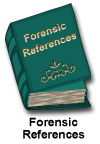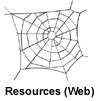|
|
 |
The
required readings for this unit are:
 Australia
Australia |
Required
Reading(s)
|
 |
Muir-Cochrane,
E. C., & Holmes, C. A. (2001). Legal and ethical
aspects of seclusion: An Australian perspective. Journal
of Psychiatric & Mental Health Nursing, 8(6),
501-506. Retrieved December 31, 2002, from Academic
Search Premier database:
http://search.epnet.com/direct.asp?an=5691508&db=aph
- Note:
This paper focuses on legal and ethical issues in
relation to the use of seclusion,
with policies and practices in Australian psychiatric
institutions viewed within the context of worldwide
trends.
|
 Canada
Canada |
Required
Reading(s)
|
 |
Insert article
here
 International
International |
Required
Reading(s)
|
 |
International
Society of Psychiatric-Mental Health Nurses. (2001).
ISPN Position Statement on the Use of Restraint and
Seclusion. Journal of Child & Adolescent Psychiatric
Nursing, 14(3), 100-101. Retrieved December 31,
2002, from Academic Search Premier database:
http://search.epnet.com/direct.asp?an=5915887&db=aph
- Outlines
the position issued by the International Society
of Psychiatric-Mental Health Nurses on the use of
restraint and seclusion
in treatment settings with vulnerable populations
across the lifespan. Definition of licensed independent
practitioners by the U.S. Health Care Financing
Administration; Advantage of advanced practice registered
nurses; Extension of the duration of physical restraint
of any kind.
|
 United Kingdom
United Kingdom |
Required
Reading(s)
|
 |
Insert article
here
 United States
United States |
Required
Reading(s)
|
 |
Staten,
P. A. (2001). Restraint, seclusion standards raise questions.
Nursing Management, 32(7), 17. Retrieved December
31, 2002, from Academic Search Premier database:
http://search.epnet.com/direct.asp?an=5882104&db=aph
- Note:
This article presents answers to queries on patient
restraint and seclusion standards
in the U.S. Classification of a bed enclosure; Assistance
to be provided to patients in behavioral restraint
or seclusion; Definition of
continuous monitoring.
|
Databases
For the full text article online,
sleuth the 'University
of Calgary/ Library/ Article Indexes':
Directions:
- Select
- Indexes and abstracts with links to full text articles
- Select
- Academic Search Premier or Expanded Academic ASAP
- Select
- Connect
-
Fill in
User ID and Pin
- Fill
in search words:
- seclusion
- restraint
- restraint
and seclusion
Top of Page
|
 |
 |
The
'recommended only' readings for this unit are the following:
 Australia
Australia |
Recommended
Reading(s)
|
 |
Insert article/book/chapter
here
 Canada
Canada |
Recommended
Reading(s)
|
 |
Insert article/book/chapter
here
 International
International |
Recommended
Reading(s)
|
 |
Insert article/book/chapter
here
 Scotland
Scotland |
Recommended
Reading(s)
|
 |
|
Macilwaine,
H., Watson, C., MacKenzie, I.(1999). Restraint versus
restraints: Defining the concepts for review and measurement.
The British Journal of Forensic Practice, 1 (3),
27-33.
- Note
the difference between countries for the use of
certain types of restraints.
Mason,
T. (1997). Seclusion and the lunar cycles. Journal
of Psychosocial Nursing, 35 (6), 18-23.
- Note
this study undertaken in a forensic hospital involved
the collection of data analyzed in relation to the
phases of the moon, in relation to all seclusion
episodes over a 1-year period (Mason, 1997, p. 14).
|
 United Kingdom
United Kingdom |
Recommended
Reading(s)
|
 |
Mason, T. (1997).
Seclusion and the lunar cycles. Journal of Psychosocial
Nursing, 35 (6), 18-23.
- Note this
study undertaken in a forensic hospital involved the collection
of data analyzed in relation to the phases of the moon,
in relation to all seclusion episodes over a 1-year period
(Mason, 1997, p. 14).
 United States
United States |
Recommended
Reading(s)
|
 |
Martinez, R.
J., Grimm, M. & Adamson, M. (1999). From the other side
of the door: Patient views of seclusion. Journal of Psychosocial
Nursing, 37 (3), 13-22.
- Note the
purpose of this study was to learn about the experience
from the experience of seclusion from the patients perspective.
Top of Page
|

|
Additional
references for this unit can be found in 'forensic
references'
of the forensic sourcebooks.
- Sleuth
'forensic reference' database for:
restraint - seclusion
Top of Page
|

|
Video's
recommended for this unit are:
|
|
Resources
(Video)
|
 |
Insert video
here
Top of Page
|

|
The
required websites to sleuth for this unit are the following:
 Australia
Australia |
Resources
(Web)
|
 |
Insert website
here
 Canada
Canada |
Resources
(Web)
|
 |
Insert website
here
 International
International |
Resources
(Web)
|
 |
Insert website
here
 United Kingdom
United Kingdom |
Resources
(Web)
|
 |
Insert website
here
 United States
United States
|
Resources
(Web)
|
 |
RIPP Restraints.
(1997). Patient Restraints. Retrieved June 12, 2002 from
RIPP Restraints Inc http://www.ripprest.com/pr.htm
RIPP Restraints.
(1997). The original polypropylene soft restraints. Retrieved
June 12, 2002 from RIPP Restraints Inc.: http://www.ripprest.com
- Note the
illustrations of the many types of restraints shown at
this site.
Top of Page
|
 |
For
additional websites on this unit, sleuth 'forensic
websites' in the forensic sourcebooks.
Top of Page
|
 |
|